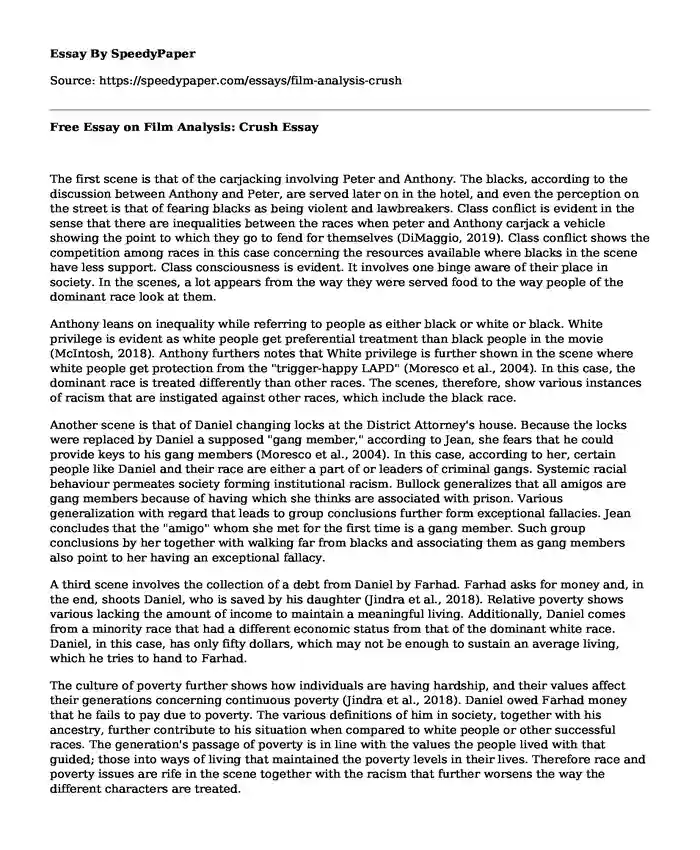
| Type of paper: | Critical thinking |
| Categories: | Race Discrimination Analysis Movie |
| Pages: | 3 |
| Wordcount: | 642 words |
The first scene is that of the carjacking involving Peter and Anthony. The blacks, according to the discussion between Anthony and Peter, are served later on in the hotel, and even the perception on the street is that of fearing blacks as being violent and lawbreakers. Class conflict is evident in the sense that there are inequalities between the races when peter and Anthony carjack a vehicle showing the point to which they go to fend for themselves (DiMaggio, 2019). Class conflict shows the competition among races in this case concerning the resources available where blacks in the scene have less support. Class consciousness is evident. It involves one binge aware of their place in society. In the scenes, a lot appears from the way they were served food to the way people of the dominant race look at them.
Anthony leans on inequality while referring to people as either black or white or black. White privilege is evident as white people get preferential treatment than black people in the movie (McIntosh, 2018). Anthony furthers notes that White privilege is further shown in the scene where white people get protection from the "trigger-happy LAPD" (Moresco et al., 2004). In this case, the dominant race is treated differently than other races. The scenes, therefore, show various instances of racism that are instigated against other races, which include the black race.
Another scene is that of Daniel changing locks at the District Attorney's house. Because the locks were replaced by Daniel a supposed "gang member," according to Jean, she fears that he could provide keys to his gang members (Moresco et al., 2004). In this case, according to her, certain people like Daniel and their race are either a part of or leaders of criminal gangs. Systemic racial behaviour permeates society forming institutional racism. Bullock generalizes that all amigos are gang members because of having which she thinks are associated with prison. Various generalization with regard that leads to group conclusions further form exceptional fallacies. Jean concludes that the "amigo" whom she met for the first time is a gang member. Such group conclusions by her together with walking far from blacks and associating them as gang members also point to her having an exceptional fallacy.
A third scene involves the collection of a debt from Daniel by Farhad. Farhad asks for money and, in the end, shoots Daniel, who is saved by his daughter (Jindra et al., 2018). Relative poverty shows various lacking the amount of income to maintain a meaningful living. Additionally, Daniel comes from a minority race that had a different economic status from that of the dominant white race. Daniel, in this case, has only fifty dollars, which may not be enough to sustain an average living, which he tries to hand to Farhad.
The culture of poverty further shows how individuals are having hardship, and their values affect their generations concerning continuous poverty (Jindra et al., 2018). Daniel owed Farhad money that he fails to pay due to poverty. The various definitions of him in society, together with his ancestry, further contribute to his situation when compared to white people or other successful races. The generation's passage of poverty is in line with the values the people lived with that guided; those into ways of living that maintained the poverty levels in their lives. Therefore race and poverty issues are rife in the scene together with the racism that further worsens the way the different characters are treated.
References
DiMaggio, A. R. (2019). Political Power in America: Class Conflict and the Subversion of Democracy. SUNY Press.
Jindra, I. W., & Jindra, M. (2018). Connecting poverty, culture, and cognition: The bridges out of poverty process. Journal of Poverty, 22(1), 42-64.
McIntosh, P. (2018). White privilege and male privilege. In Privilege (pp. 28-40). Routledge.
Moresco, R., Muro, J., Isham, M., Bullock, S., Cheadle, D., Dillon, M., Esposito, J.,Tate, L. (2005). Crash, (2004).
Cite this page
Free Essay on Film Analysis: Crush. (2023, May 02). Retrieved from https://speedypaper.com/essays/film-analysis-crush
Request Removal
If you are the original author of this essay and no longer wish to have it published on the SpeedyPaper website, please click below to request its removal:
- Comparison Essay Sample on the Capital Structures of Coca-Cola Company and Nike
- Free Paper with a Response to the Rejection Letter
- Essay Sample: Improving Organizational Culture
- Sociological Role of the School Institution
- "Walking Around" by Neruda
- Using Humans for Research. Paper Sample
- Essay Sample on Meniere Infection
Popular categories




